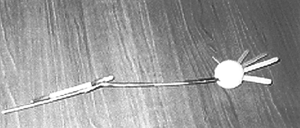How People Learn:
Brain, Mind,
Experience, and School
|
|
|
| |
BOX 7.5
Physical Models
Physical models, like models of solar systems or elbows, are microcosms
of systems that draw heavily on children's intuitions about resemblance
to sustain the relationship between the world being modeled and the
model itself. The photograph below displays a child's model of the
elbow. Note, for instance, the rubber bands that mimic the connective
function of ligaments and the wooden dowels that are arranged so that
their translation in the vertical plane cannot exceed 180 degrees.
Though the search for function is supported by initial resemblance, what
counts as resemblance typically changes as children revise their models.
For example, attempts to make models exemplify elbow motion often lead
to an interest in the way muscles might be arranged (from Lehrer and
Schauble, 1996a, b).

Child's Model of an Elbow
|
|
|
|
|